Introduction: the aim and the tasks of the

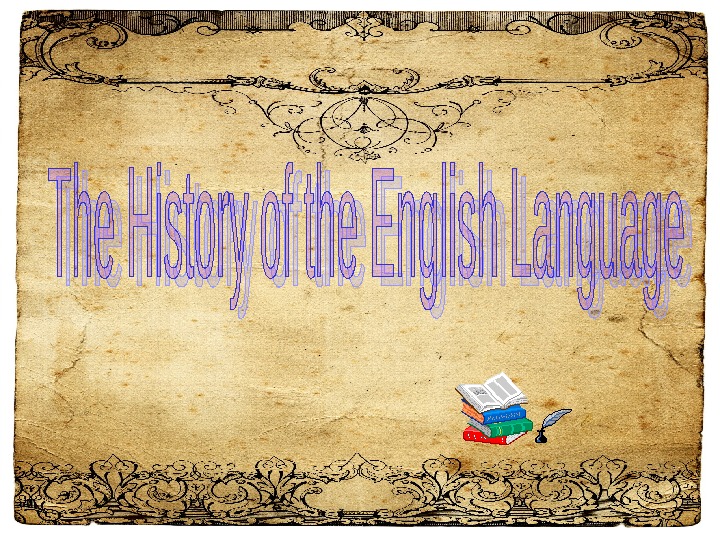
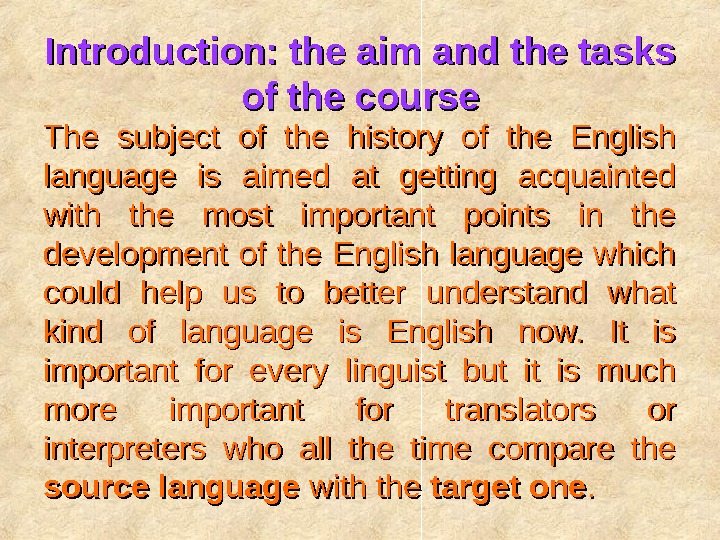
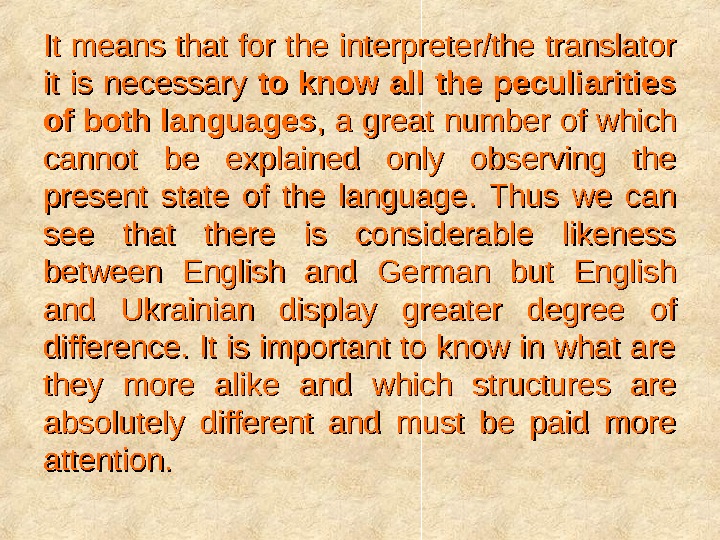

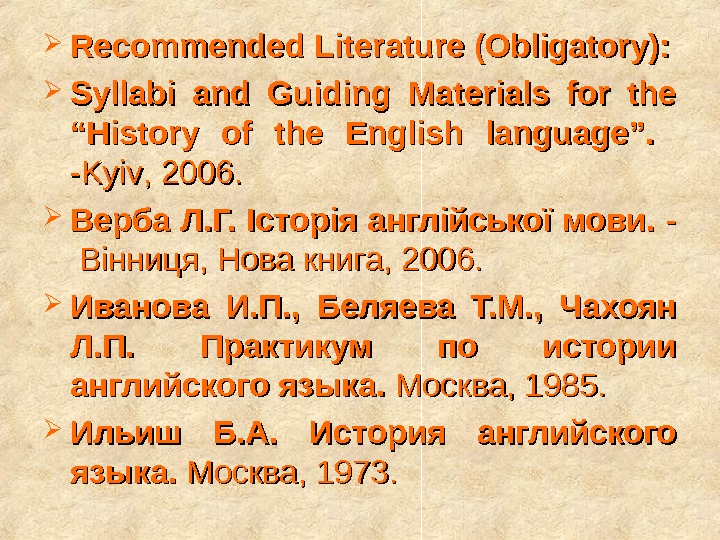
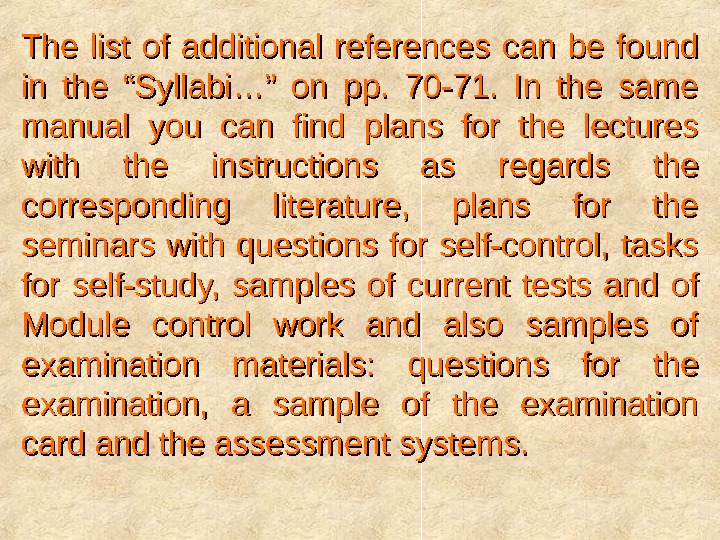
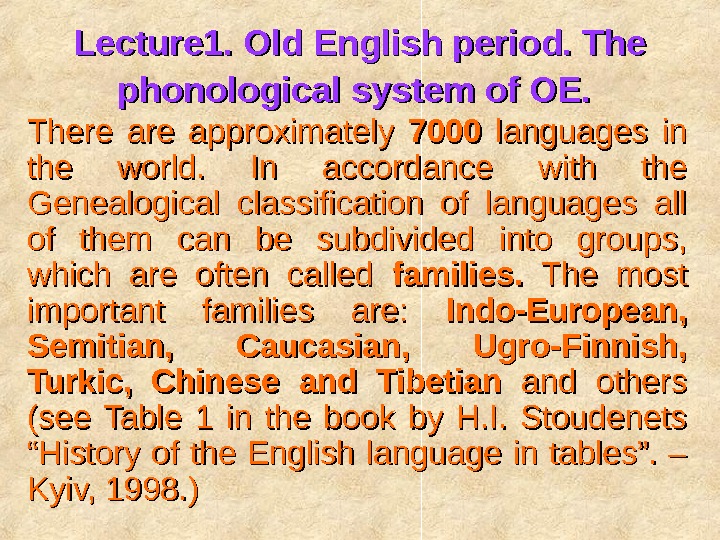

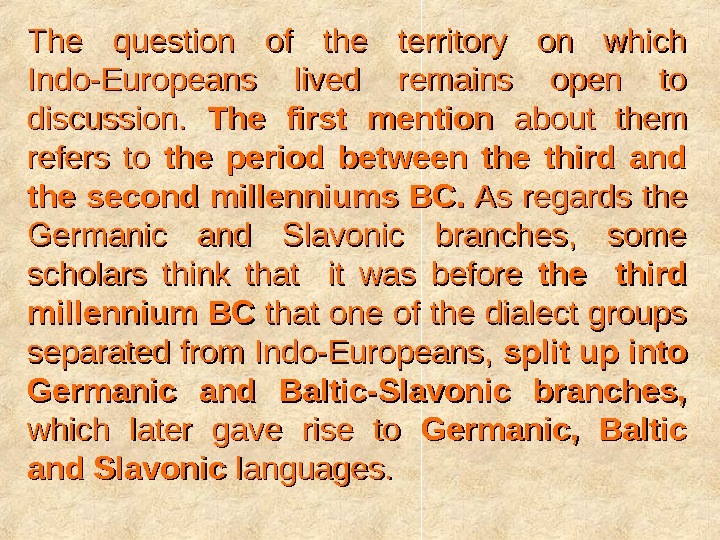
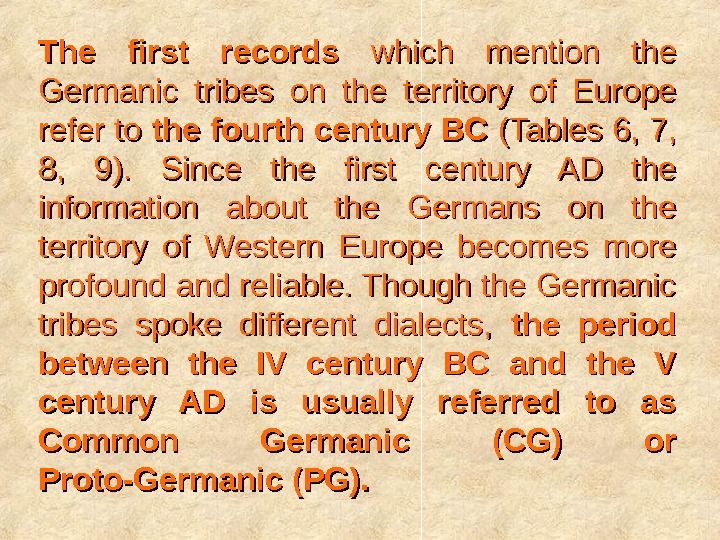
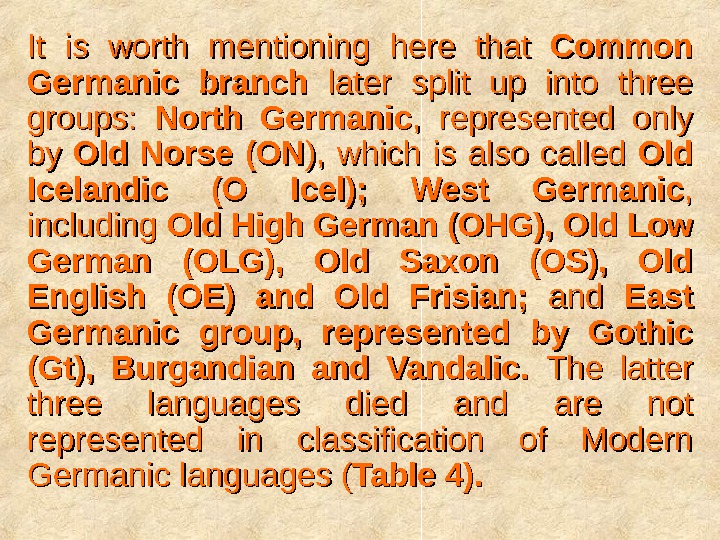
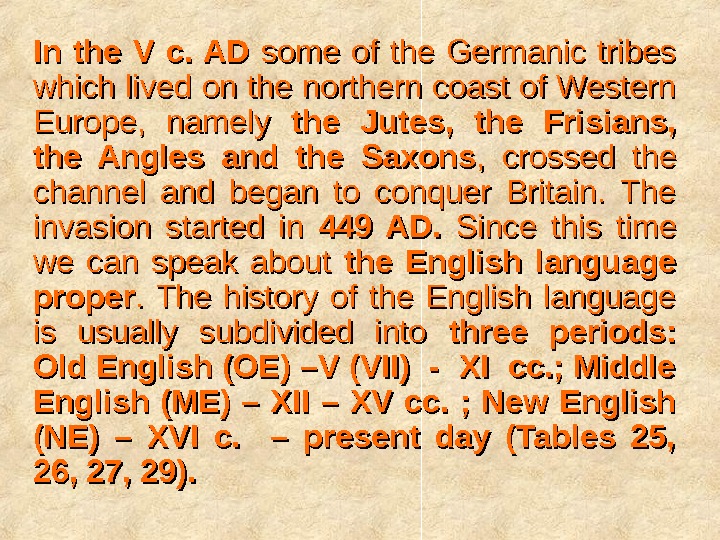
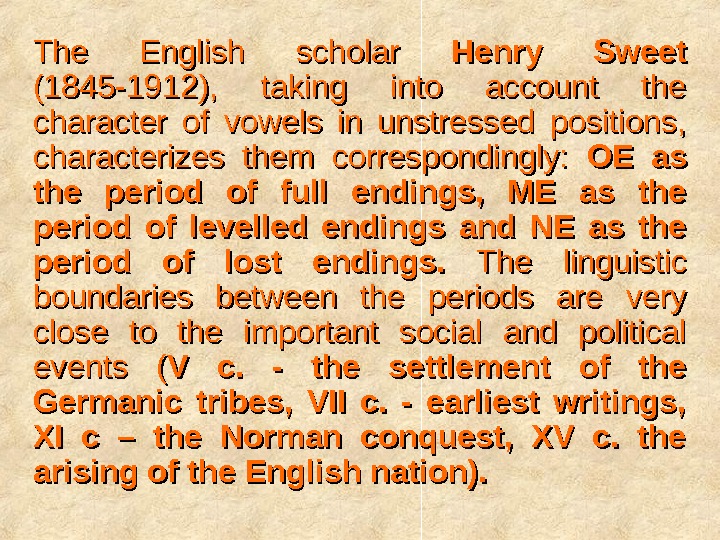
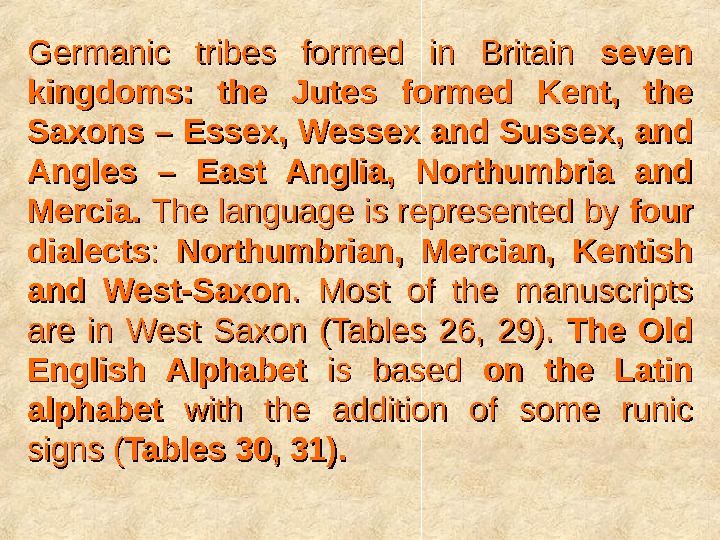



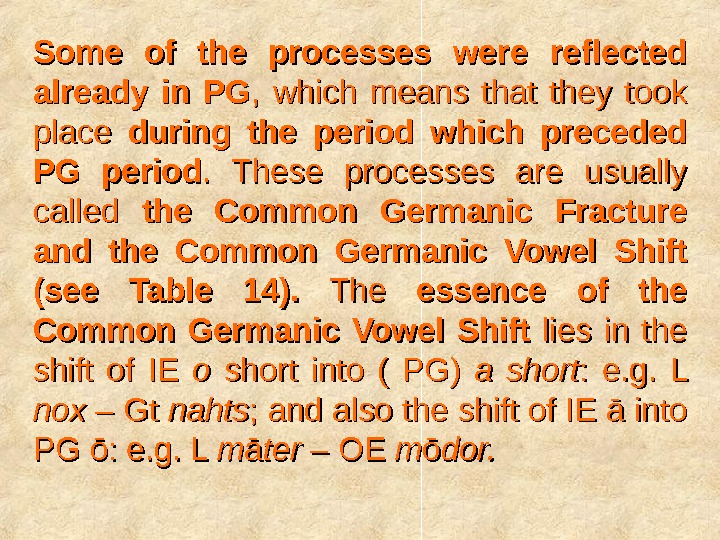
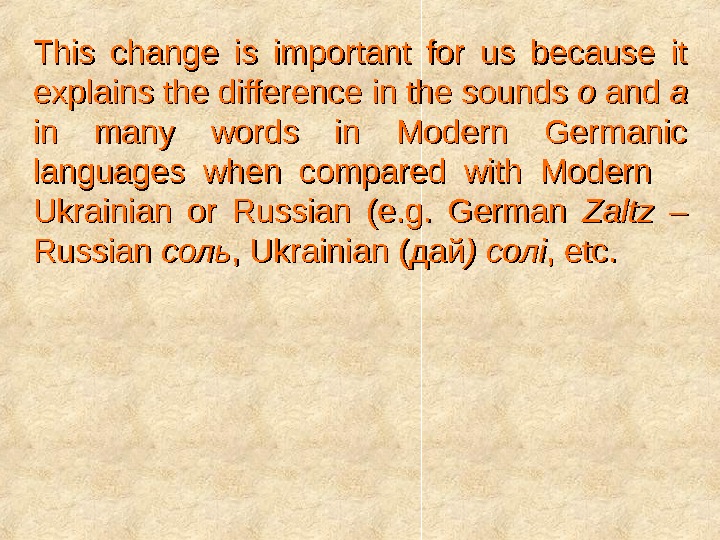
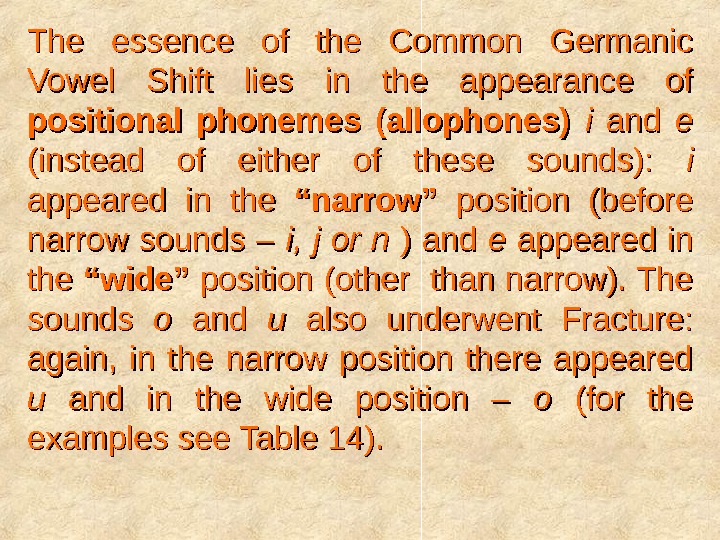
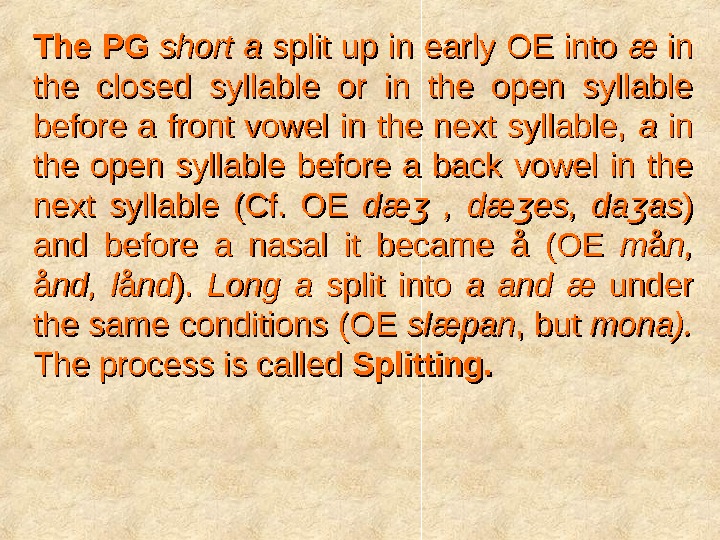
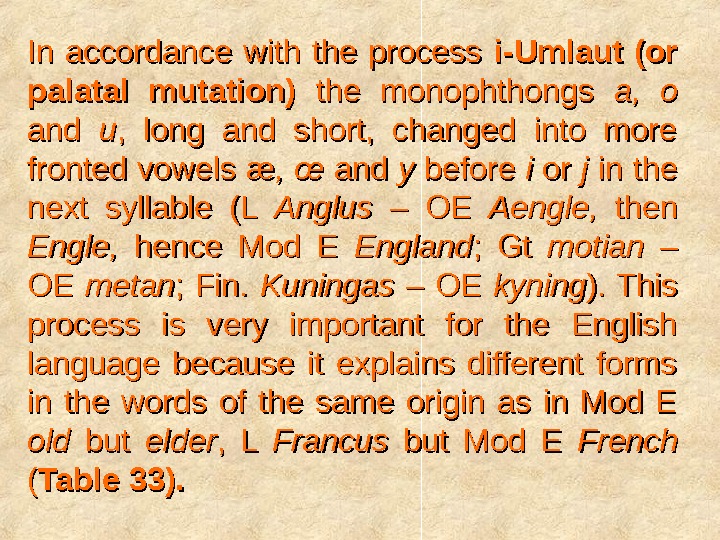
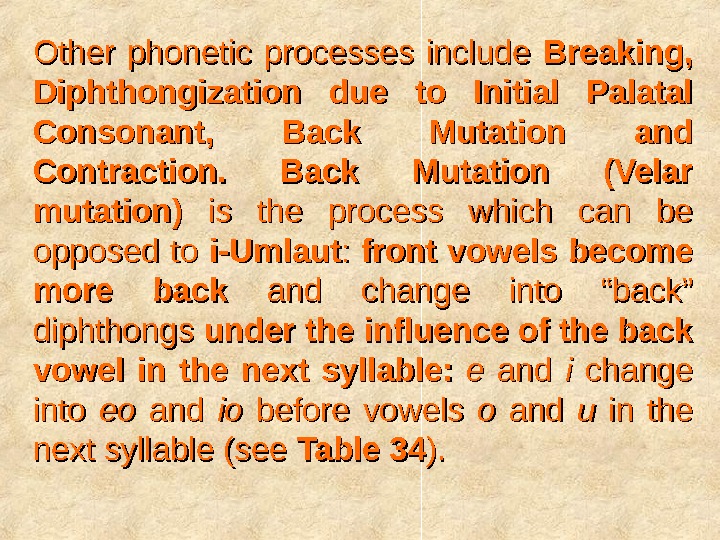
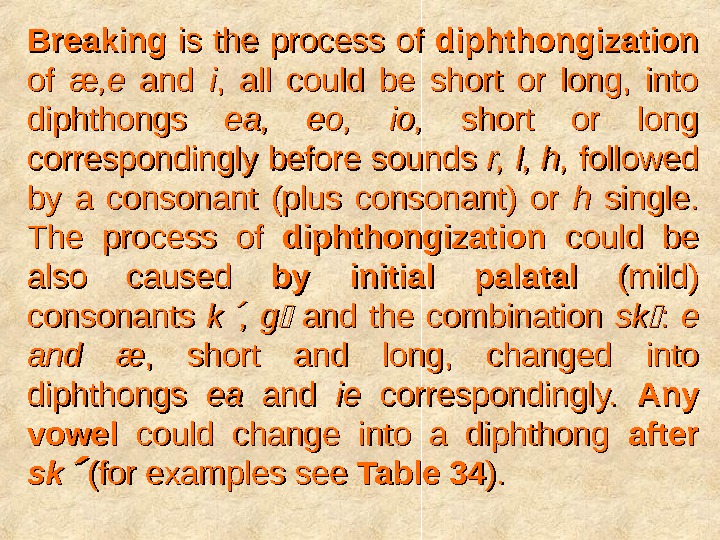
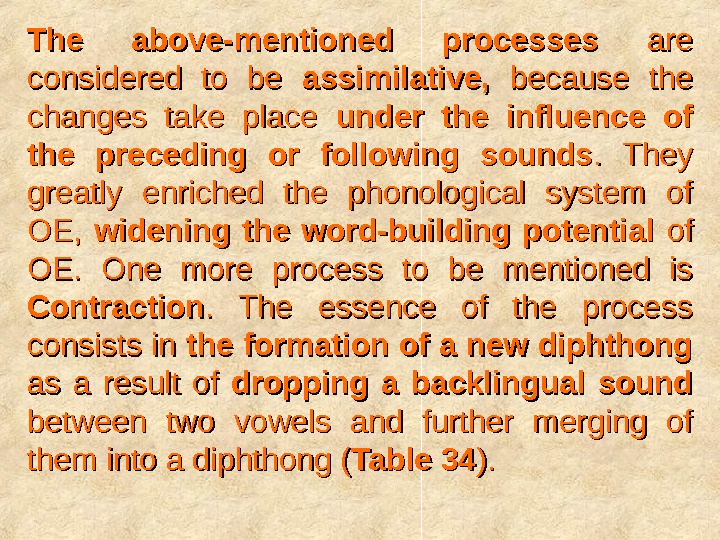
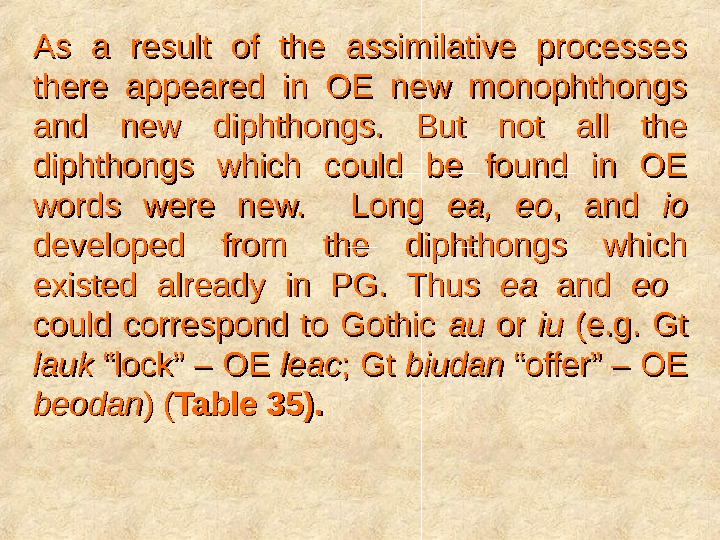
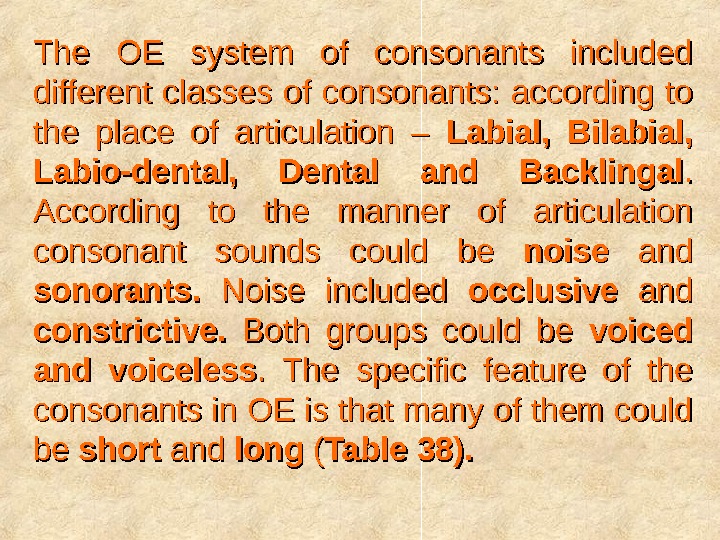
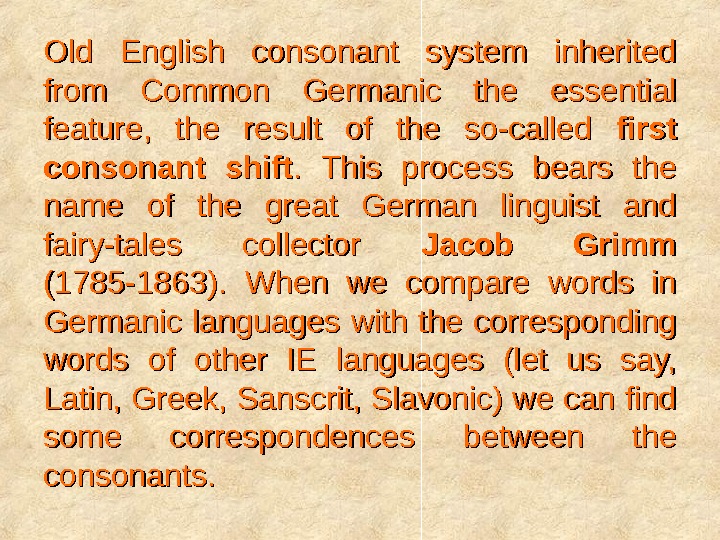
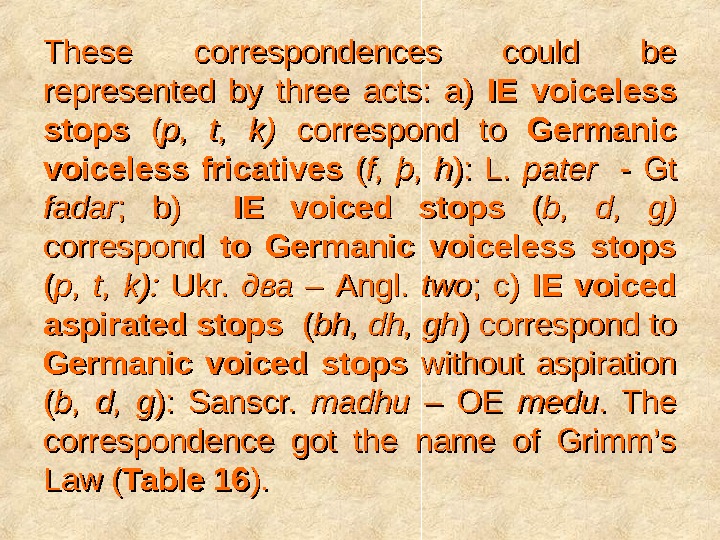
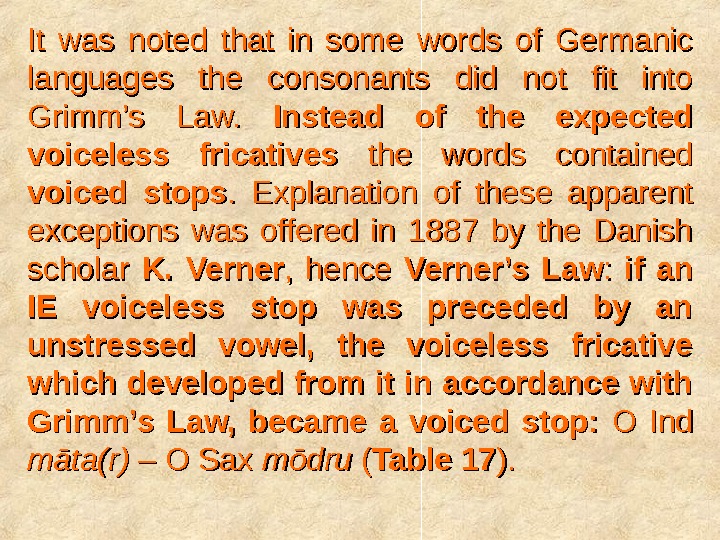
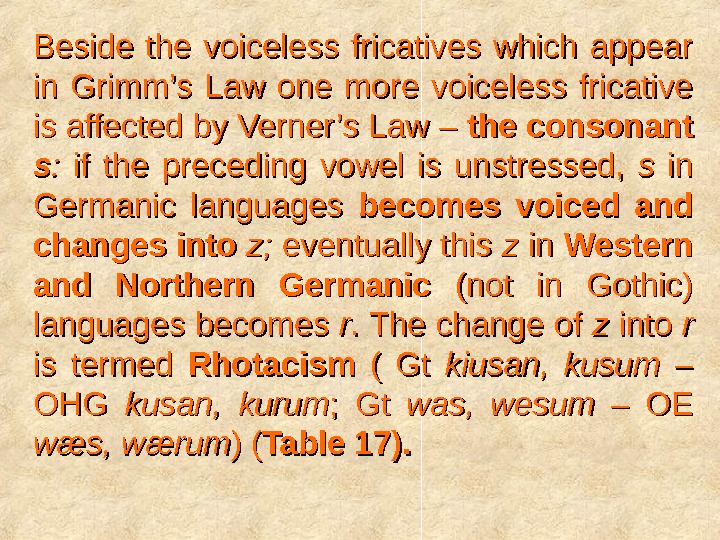
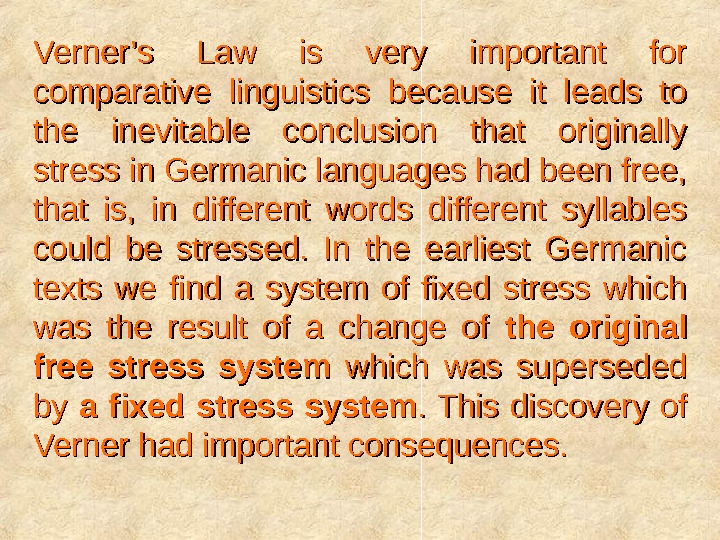
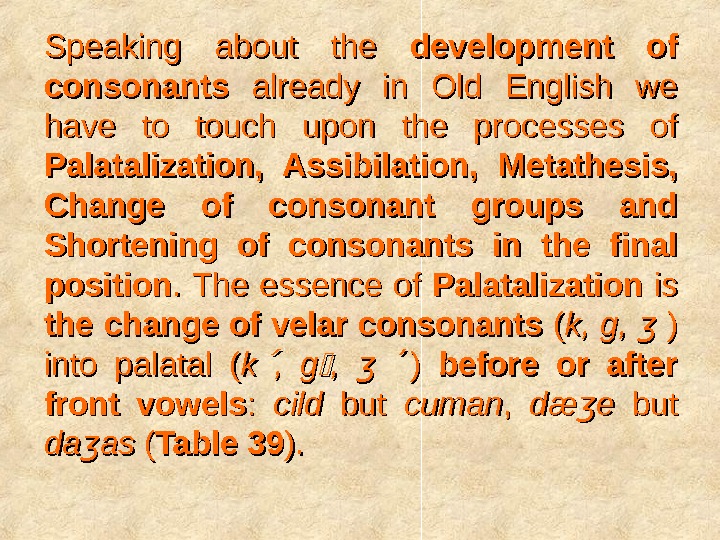

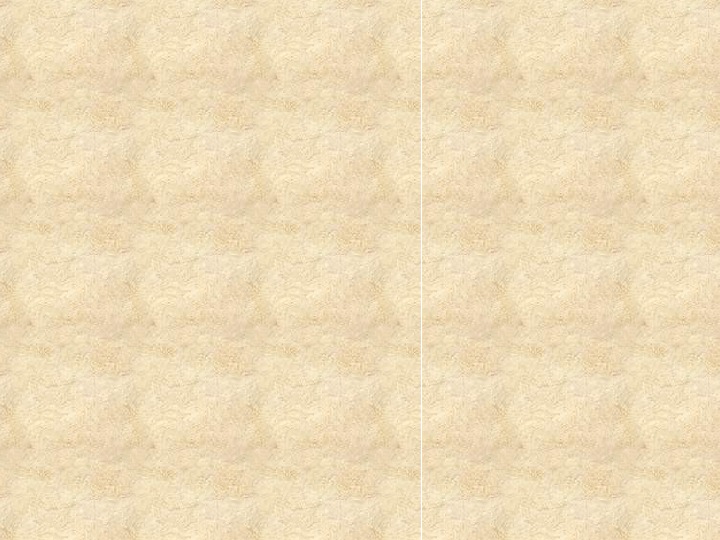
the_history_of_the_english_language.ppt
- Размер: 2.3 Mегабайта
- Количество слайдов: 35
Описание презентации Introduction: the aim and the tasks of the по слайдам

 Introduction: the aim and the tasks of the course The subject of the history of the English language is aimed at getting acquainted with the most important points in the development of the English language which could help us to better understand what kind of language is English now. It is important for every linguist but it is much more important for translators or interpreters who all the time compare the source language with the target one. .
Introduction: the aim and the tasks of the course The subject of the history of the English language is aimed at getting acquainted with the most important points in the development of the English language which could help us to better understand what kind of language is English now. It is important for every linguist but it is much more important for translators or interpreters who all the time compare the source language with the target one. .
 It means that for the interpreter/the translator it is necessary to know all the peculiarities of both languages , a great number of which cannot be explained only observing the present state of the language. Thus we can see that there is considerable likeness between English and German but English and Ukrainian display greater degree of difference. It is important to know in what are they more alike and which structures are absolutely different and must be paid more attention.
It means that for the interpreter/the translator it is necessary to know all the peculiarities of both languages , a great number of which cannot be explained only observing the present state of the language. Thus we can see that there is considerable likeness between English and German but English and Ukrainian display greater degree of difference. It is important to know in what are they more alike and which structures are absolutely different and must be paid more attention.
 We are often put before the dilemma of translating into Ukrainian sentences with the Present Perfect and cannot understand why it is translated into Ukrainian минулим часом. In the same way it is difficult to understand why plural of book is books , but plural of woman is women. Many problems arise with the spelling system in English: why does the word daughter have eight letters but only four sounds. History of English helps us to understand these and many other problems.
We are often put before the dilemma of translating into Ukrainian sentences with the Present Perfect and cannot understand why it is translated into Ukrainian минулим часом. In the same way it is difficult to understand why plural of book is books , but plural of woman is women. Many problems arise with the spelling system in English: why does the word daughter have eight letters but only four sounds. History of English helps us to understand these and many other problems.
 Recommended Literature (Obligatory): Syllabi and Guiding Materials for the “History of the English language”. -Kyiv , 2006. Верба Л. Г. Історія англійської мови. — — Вінниця, Нова книга, 2006. Иванова И. П. , Беляева Т. М. , Чахоян Л. П. Практикум по истории английского языка. Москва, 1985. Ильиш Б. А. История английского языка. Москва, 1973.
Recommended Literature (Obligatory): Syllabi and Guiding Materials for the “History of the English language”. -Kyiv , 2006. Верба Л. Г. Історія англійської мови. — — Вінниця, Нова книга, 2006. Иванова И. П. , Беляева Т. М. , Чахоян Л. П. Практикум по истории английского языка. Москва, 1985. Ильиш Б. А. История английского языка. Москва, 1973.
 The list of additional references can be found in the “Syllabi…” on pp. 70 -71. In the same manual you can find plans for the lectures with the instructions as regards the corresponding literature, plans for the seminars with questions for self-control, tasks for self-study, samples of current tests and of Module control work and also samples of examination materials: questions for the examination, a sample of the examination card and the assessment systems.
The list of additional references can be found in the “Syllabi…” on pp. 70 -71. In the same manual you can find plans for the lectures with the instructions as regards the corresponding literature, plans for the seminars with questions for self-control, tasks for self-study, samples of current tests and of Module control work and also samples of examination materials: questions for the examination, a sample of the examination card and the assessment systems.
 Lecture 1. Old English period. The phonological system of OE. There are approximately 7000 languages in the world. In accordance with the Genealogical classification of languages all of them can be subdivided into groups, which are often called families. The most important families are: Indo-European, Semitian, Caucasian, Ugro-Finnish, Turkic, Chinese and Tibetian and others (see Table 1 in the book by H. I. Stoudenets “History of the English language in tables”. – Kyiv, 1998. )
Lecture 1. Old English period. The phonological system of OE. There are approximately 7000 languages in the world. In accordance with the Genealogical classification of languages all of them can be subdivided into groups, which are often called families. The most important families are: Indo-European, Semitian, Caucasian, Ugro-Finnish, Turkic, Chinese and Tibetian and others (see Table 1 in the book by H. I. Stoudenets “History of the English language in tables”. – Kyiv, 1998. )
 Indo-European family has 12 most important branches : : Indian, Iranian, Baltic, Slavonic, Germanic, Romanic, Celtic, Greek, Albanian, Armenian, Hettish (Table 3). Thus English belongs to the Germanic branch of Indo-European family while Ukrainian belongs to the Slavonic branch of the same family , , which means that they have a common ancestor. It is usually referred to as Common Indo-European or Proto-Indo-European (Proto IE). It existed approximately 6 -7 thousand years BC.
Indo-European family has 12 most important branches : : Indian, Iranian, Baltic, Slavonic, Germanic, Romanic, Celtic, Greek, Albanian, Armenian, Hettish (Table 3). Thus English belongs to the Germanic branch of Indo-European family while Ukrainian belongs to the Slavonic branch of the same family , , which means that they have a common ancestor. It is usually referred to as Common Indo-European or Proto-Indo-European (Proto IE). It existed approximately 6 -7 thousand years BC.
 The question of the territory on which Indo-Europeans lived remains open to discussion. The first mention about them refers to the period between the third and the second millenniums BC. As regards the Germanic and Slavonic branches, some scholars think that it was before the third millennium BC that one of the dialect groups separated from Indo-Europeans, split up into Germanic and Baltic-Slavonic branches, which later gave rise to Germanic, Baltic and Slavonic languages.
The question of the territory on which Indo-Europeans lived remains open to discussion. The first mention about them refers to the period between the third and the second millenniums BC. As regards the Germanic and Slavonic branches, some scholars think that it was before the third millennium BC that one of the dialect groups separated from Indo-Europeans, split up into Germanic and Baltic-Slavonic branches, which later gave rise to Germanic, Baltic and Slavonic languages.
 The first records which mention the Germanic tribes on the territory of Europe refer to the fourth century BC (Tables 6, 7, 8, 9). Since the first century AD the information about the Germans on the territory of Western Europe becomes more profound and reliable. Though the Germanic tribes spoke different dialects, the period between the IV century BC and the V century AD is usually referred to as Common Germanic (CG) or Proto-Germanic (PG).
The first records which mention the Germanic tribes on the territory of Europe refer to the fourth century BC (Tables 6, 7, 8, 9). Since the first century AD the information about the Germans on the territory of Western Europe becomes more profound and reliable. Though the Germanic tribes spoke different dialects, the period between the IV century BC and the V century AD is usually referred to as Common Germanic (CG) or Proto-Germanic (PG).
 It is worth mentioning here that Common Germanic branch later split up into three groups: North Germanic , represented only by by Old Norse (ON ), which is also called Old Icelandic (O Icel); West Germanic , , including Old High German (OHG), Old Low German (OLG), Old Saxon (OS), Old English (OE) and Old Frisian; and East Germanic group, represented by Gothic (Gt), Burgandian and Vandalic. The latter three languages died and are not represented in classification of Modern Germanic languages ( Table 4).
It is worth mentioning here that Common Germanic branch later split up into three groups: North Germanic , represented only by by Old Norse (ON ), which is also called Old Icelandic (O Icel); West Germanic , , including Old High German (OHG), Old Low German (OLG), Old Saxon (OS), Old English (OE) and Old Frisian; and East Germanic group, represented by Gothic (Gt), Burgandian and Vandalic. The latter three languages died and are not represented in classification of Modern Germanic languages ( Table 4).
 In the V c. AD some of the Germanic tribes which lived on the northern coast of Western Europe, namely the Jutes, the Frisians, the Angles and the Saxons , crossed the channel and began to conquer Britain. The invasion started in 449 AD. Since this time we can speak about the English language proper. The history of the English language is usually subdivided into three periods: Old English (OE) –V (VII) — XI cc. ; Middle English (ME) – XII – XV cc. ; New English (NE) – XVI c. – present day (Tables 25, 26, 27, 29).
In the V c. AD some of the Germanic tribes which lived on the northern coast of Western Europe, namely the Jutes, the Frisians, the Angles and the Saxons , crossed the channel and began to conquer Britain. The invasion started in 449 AD. Since this time we can speak about the English language proper. The history of the English language is usually subdivided into three periods: Old English (OE) –V (VII) — XI cc. ; Middle English (ME) – XII – XV cc. ; New English (NE) – XVI c. – present day (Tables 25, 26, 27, 29).
 The English scholar Henry Sweet (1845 -1912), taking into account the character of vowels in unstressed positions, characterizes them correspondingly: OE as the period of full endings, ME as the period of levelled endings and NE as the period of lost endings. The linguistic boundaries between the periods are very close to the important social and political events ( V c. — the settlement of the Germanic tribes, VII c. — earliest writings, XI c – the Norman conquest, XV c. the arising of the English nation).
The English scholar Henry Sweet (1845 -1912), taking into account the character of vowels in unstressed positions, characterizes them correspondingly: OE as the period of full endings, ME as the period of levelled endings and NE as the period of lost endings. The linguistic boundaries between the periods are very close to the important social and political events ( V c. — the settlement of the Germanic tribes, VII c. — earliest writings, XI c – the Norman conquest, XV c. the arising of the English nation).
 Germanic tribes formed in Britain seven kingdoms: the Jutes formed Kent, the Saxons – Essex, Wessex and Sussex, and Angles – East Anglia, Northumbria and Mercia. The language is represented by four dialects : : Northumbrian, Mercian, Kentish and West-Saxon. Most of the manuscripts are in West Saxon (Tables 26, 29). The Old English Alphabet is based on the Latin alphabet with the addition of some runic signs ( Tables 30, 31). .
Germanic tribes formed in Britain seven kingdoms: the Jutes formed Kent, the Saxons – Essex, Wessex and Sussex, and Angles – East Anglia, Northumbria and Mercia. The language is represented by four dialects : : Northumbrian, Mercian, Kentish and West-Saxon. Most of the manuscripts are in West Saxon (Tables 26, 29). The Old English Alphabet is based on the Latin alphabet with the addition of some runic signs ( Tables 30, 31). .
 Each of the periods may be characterized by specific features in different aspects of the language: phonology, grammar and vocabulary. If we approach the analysis of the English language of the OE period, first of all, we have to mention the shift of stress in comparison with IE. If in IE there were two kinds stress — musical and dynamic , , in in Germanic languages only dynamic stress is preserved. In In IEIE stress was free and movable , , In In PG (and OE) it became fixed upon the first syllable primarily.
Each of the periods may be characterized by specific features in different aspects of the language: phonology, grammar and vocabulary. If we approach the analysis of the English language of the OE period, first of all, we have to mention the shift of stress in comparison with IE. If in IE there were two kinds stress — musical and dynamic , , in in Germanic languages only dynamic stress is preserved. In In IEIE stress was free and movable , , In In PG (and OE) it became fixed upon the first syllable primarily.
 Comparing OE system of vowels with IE and PG (Table 32) we can arrive at a conclusion that the system of vowels in OE changed: in IE there were 10 monophthongs (five short and five long). In In PGPG they are only 8: 8: there is no short aa and long oo ; there are also allophones (positional variants of the phonemes): e/i and o/u. In In OEOE there are already 15 monophthongs : there appeared five new phonemes : : ææ short and long, yy short and yy long and åå nasal. .
Comparing OE system of vowels with IE and PG (Table 32) we can arrive at a conclusion that the system of vowels in OE changed: in IE there were 10 monophthongs (five short and five long). In In PGPG they are only 8: 8: there is no short aa and long oo ; there are also allophones (positional variants of the phonemes): e/i and o/u. In In OEOE there are already 15 monophthongs : there appeared five new phonemes : : ææ short and long, yy short and yy long and åå nasal. .
 If we compare PG diphthongs ai, au, eu, iu (Table 32) with OE ea, eo, ie, io short and long , it could seem possible to say that in OE all the diphthongs are absolutely new. At least so the eight diphthongs look at first sight. Then it is necessary to explain how, why and when the “new” phonemes appeared. The most general conclusion may be formulated in the following way: new phonemes in OE appeared due to different phonetic processes.
If we compare PG diphthongs ai, au, eu, iu (Table 32) with OE ea, eo, ie, io short and long , it could seem possible to say that in OE all the diphthongs are absolutely new. At least so the eight diphthongs look at first sight. Then it is necessary to explain how, why and when the “new” phonemes appeared. The most general conclusion may be formulated in the following way: new phonemes in OE appeared due to different phonetic processes.
 Some of the processes were reflected already in PG , which means that they took place during the period which preceded PG period. These processes are usually called the Common Germanic Fracture and the Common Germanic Vowel Shift (see Table 14). The essence of the Common Germanic Vowel Shift lies in the shift of IE oo short into ( PG) a short : e. g. L noxnox – Gt nahts ; and also the shift of IE āā into PG PG ōō : e. g. L mm āā terter – OE mm ōō dor.
Some of the processes were reflected already in PG , which means that they took place during the period which preceded PG period. These processes are usually called the Common Germanic Fracture and the Common Germanic Vowel Shift (see Table 14). The essence of the Common Germanic Vowel Shift lies in the shift of IE oo short into ( PG) a short : e. g. L noxnox – Gt nahts ; and also the shift of IE āā into PG PG ōō : e. g. L mm āā terter – OE mm ōō dor.
 This change is important for us because it explains the difference in the sounds o o and a a in many words in Modern Germanic languages when compared with Modern Ukrainian or Russian (e. g. German Zaltz – Russian соль , Ukrainian (дай ) солі , etc. .
This change is important for us because it explains the difference in the sounds o o and a a in many words in Modern Germanic languages when compared with Modern Ukrainian or Russian (e. g. German Zaltz – Russian соль , Ukrainian (дай ) солі , etc. .
 The essence of the Common Germanic Vowel Shift lies in the appearance of positional phonemes (allophones) ii and e e (instead of either of these sounds): ii appeared in the “narrow” position (before narrow sounds – i, j or n ) and e e appeared in the “wide” position (other than narrow). The sounds oo and uu also underwent Fracture: again, in the narrow position there appeared uu and in the wide position – oo (for the examples see Table 14).
The essence of the Common Germanic Vowel Shift lies in the appearance of positional phonemes (allophones) ii and e e (instead of either of these sounds): ii appeared in the “narrow” position (before narrow sounds – i, j or n ) and e e appeared in the “wide” position (other than narrow). The sounds oo and uu also underwent Fracture: again, in the narrow position there appeared uu and in the wide position – oo (for the examples see Table 14).
 The PG short a split up in early OE into ææ in in the closed syllable or in the open syllable before a front vowel in the next syllable, a a in in the open syllable before a back vowel in the next syllable (Cf. OE dd ææ ʒʒ , d ææ ʒʒ es, da ʒʒ asas ) ) and before a nasal it became åå (OE mm åå n, n, åå nd, l åå ndnd ). ). Long a split into a and ææ under the same conditions (OE slsl ææ panpan , but mona). The process is called Splitting.
The PG short a split up in early OE into ææ in in the closed syllable or in the open syllable before a front vowel in the next syllable, a a in in the open syllable before a back vowel in the next syllable (Cf. OE dd ææ ʒʒ , d ææ ʒʒ es, da ʒʒ asas ) ) and before a nasal it became åå (OE mm åå n, n, åå nd, l åå ndnd ). ). Long a split into a and ææ under the same conditions (OE slsl ææ panpan , but mona). The process is called Splitting.
 In accordance with the process i-Umlaut (or palatal mutation) the monophthongs a, o and uu , long and short, changed into more fronted vowels ææ , , œœ and yy before ii or or jj in the next syllable (L Anglus – OE Aengle, then Engle, hence Mod E England ; Gt motian – – OE OE metan ; Fin. Kuningas – OE kyning ). This process is very important for the English language because it explains different forms in the words of the same origin as in Mod E oldold but elder , L Francus but Mod E French (( Table 33).
In accordance with the process i-Umlaut (or palatal mutation) the monophthongs a, o and uu , long and short, changed into more fronted vowels ææ , , œœ and yy before ii or or jj in the next syllable (L Anglus – OE Aengle, then Engle, hence Mod E England ; Gt motian – – OE OE metan ; Fin. Kuningas – OE kyning ). This process is very important for the English language because it explains different forms in the words of the same origin as in Mod E oldold but elder , L Francus but Mod E French (( Table 33).
 Other phonetic processes include Breaking, Diphthongization due to Initial Palatal Consonant, Back Mutation and Contraction. Back Mutation (Velar mutation) is the process which can be opposed to i-Umlaut : : front vowels become more back and change into “back” diphthongs under the influence of the back vowel in the next syllable: ee and ii change into eoeo and ioio before vowels oo and uu in the next syllable (see Table 34 ). ).
Other phonetic processes include Breaking, Diphthongization due to Initial Palatal Consonant, Back Mutation and Contraction. Back Mutation (Velar mutation) is the process which can be opposed to i-Umlaut : : front vowels become more back and change into “back” diphthongs under the influence of the back vowel in the next syllable: ee and ii change into eoeo and ioio before vowels oo and uu in the next syllable (see Table 34 ). ).
 Breaking is the process of diphthongization of of ææ , e, e and ii , all could be short or long, into diphthongs ea, eo, io, short or long correspondingly before sounds r, l, h, followed by a consonant (plus consonant) or hh single. The process of diphthongization could be also caused by initial palatal (mild) consonants kk , g and the combination sksk : : e e and ææ , short and long, changed into diphthongs ea ea and ie ie correspondingly. Any vowel could change into a diphthong after sksk (for examples see Table 34 )). .
Breaking is the process of diphthongization of of ææ , e, e and ii , all could be short or long, into diphthongs ea, eo, io, short or long correspondingly before sounds r, l, h, followed by a consonant (plus consonant) or hh single. The process of diphthongization could be also caused by initial palatal (mild) consonants kk , g and the combination sksk : : e e and ææ , short and long, changed into diphthongs ea ea and ie ie correspondingly. Any vowel could change into a diphthong after sksk (for examples see Table 34 )). .
 The above-mentioned processes are considered to be assimilative, because the changes take place under the influence of the preceding or following sounds. They greatly enriched the phonological system of OE, widening the word-building potential of OE. One more process to be mentioned is Contraction. The essence of the process consists in the formation of a new diphthong as a result of dropping a backlingual sound between two vowels and further merging of them into a diphthong ( Table 34 ). ).
The above-mentioned processes are considered to be assimilative, because the changes take place under the influence of the preceding or following sounds. They greatly enriched the phonological system of OE, widening the word-building potential of OE. One more process to be mentioned is Contraction. The essence of the process consists in the formation of a new diphthong as a result of dropping a backlingual sound between two vowels and further merging of them into a diphthong ( Table 34 ). ).
 As a result of the assimilative processes there appeared in OE new monophthongs and new diphthongs. But not all the diphthongs which could be found in OE words were new. Long ea, eoeo , and ioio developed from the diphthongs which existed already in PG. Thus eaea and eoeo could correspond to Gothic au au or iuiu (e. g. Gt lauk “lock” – OE leac ; Gt biudan “offer” – OE beodan ) () ( Table 35).
As a result of the assimilative processes there appeared in OE new monophthongs and new diphthongs. But not all the diphthongs which could be found in OE words were new. Long ea, eoeo , and ioio developed from the diphthongs which existed already in PG. Thus eaea and eoeo could correspond to Gothic au au or iuiu (e. g. Gt lauk “lock” – OE leac ; Gt biudan “offer” – OE beodan ) () ( Table 35).
 The OE system of consonants included different classes of consonants: according to the place of articulation – Labial, Bilabial, Labio-dental, Dental and Backlingal. . According to the manner of articulation consonant sounds could be noise and sonorants. Noise included occlusive and constrictive. Both groups could be voiced and voiceless. The specific feature of the consonants in OE is that many of them could be be short andand long ( ( Table 38).
The OE system of consonants included different classes of consonants: according to the place of articulation – Labial, Bilabial, Labio-dental, Dental and Backlingal. . According to the manner of articulation consonant sounds could be noise and sonorants. Noise included occlusive and constrictive. Both groups could be voiced and voiceless. The specific feature of the consonants in OE is that many of them could be be short andand long ( ( Table 38).
 Old English consonant system inherited from Common Germanic the essential feature, the result of the so-called first consonant shift. This process bears the name of the great German linguist and fairy-tales collector Jacob Grimm (1785 -1863). When we compare words in Germanic languages with the corresponding words of other IE languages (let us say, Latin, Greek, Sanscrit, Slavonic) we can find some correspondences between the consonants.
Old English consonant system inherited from Common Germanic the essential feature, the result of the so-called first consonant shift. This process bears the name of the great German linguist and fairy-tales collector Jacob Grimm (1785 -1863). When we compare words in Germanic languages with the corresponding words of other IE languages (let us say, Latin, Greek, Sanscrit, Slavonic) we can find some correspondences between the consonants.
 These correspondences could be represented by three acts: a) IE voiceless stops ( ( p, t, k) correspond to Germanic voiceless fricatives ( ( f, f, þþ , h ): L. pater — Gt fadar ; b) IE voiced stops ( ( b, d, g) correspond to Germanic voiceless stops (( p, t, k): Ukr. двадва – – Angl. twotwo ; c) IE voiced aspirated stops ( ( bh, dh, gh ) correspond to Germanic voiced stops without aspiration (( b, d, g ): Sanscr. madhu – OE medu. The correspondence got the name of Grimm’s Law ( Table 16 ). ).
These correspondences could be represented by three acts: a) IE voiceless stops ( ( p, t, k) correspond to Germanic voiceless fricatives ( ( f, f, þþ , h ): L. pater — Gt fadar ; b) IE voiced stops ( ( b, d, g) correspond to Germanic voiceless stops (( p, t, k): Ukr. двадва – – Angl. twotwo ; c) IE voiced aspirated stops ( ( bh, dh, gh ) correspond to Germanic voiced stops without aspiration (( b, d, g ): Sanscr. madhu – OE medu. The correspondence got the name of Grimm’s Law ( Table 16 ). ).
 It was noted that in some words of Germanic languages the consonants did not fit into Grimm’s Law. Instead of the expected voiceless fricatives the words contained voiced stops. Explanation of these apparent exceptions was offered in 1887 by the Danish scholar K. Verner , hence Verner’s Law : : if an IE voiceless stop was preceded by an unstressed vowel, the voiceless fricative which developed from it in accordance with Grimm’s Law, became a voiced stop: O Ind mm āā ta(r) – O Sax mm ōō dru (( Table 17 ). ).
It was noted that in some words of Germanic languages the consonants did not fit into Grimm’s Law. Instead of the expected voiceless fricatives the words contained voiced stops. Explanation of these apparent exceptions was offered in 1887 by the Danish scholar K. Verner , hence Verner’s Law : : if an IE voiceless stop was preceded by an unstressed vowel, the voiceless fricative which developed from it in accordance with Grimm’s Law, became a voiced stop: O Ind mm āā ta(r) – O Sax mm ōō dru (( Table 17 ). ).
 Beside the voiceless fricatives which appear in Grimm’s Law one more voiceless fricative is affected by Verner’s Law – the consonant ss : : if the preceding vowel is unstressed, ss in Germanic languages becomes voiced and changes into z; z; eventually this zz in in Western and Northern Germanic (not in Gothic) languages becomes rr. The change of zz into rr is termed Rhotacism ( Gt kiusan, kusum – – OHG kusan, kurum ; Gt was, wesum – OE ww ææ s, w ææ rumrum ) () ( Table 17).
Beside the voiceless fricatives which appear in Grimm’s Law one more voiceless fricative is affected by Verner’s Law – the consonant ss : : if the preceding vowel is unstressed, ss in Germanic languages becomes voiced and changes into z; z; eventually this zz in in Western and Northern Germanic (not in Gothic) languages becomes rr. The change of zz into rr is termed Rhotacism ( Gt kiusan, kusum – – OHG kusan, kurum ; Gt was, wesum – OE ww ææ s, w ææ rumrum ) () ( Table 17).
 Verner’s Law is very important for comparative linguistics because it leads to the inevitable conclusion that originally stress in Germanic languages had been free, that is, in different words different syllables could be stressed. In the earliest Germanic texts we find a system of fixed stress which was the result of a change of the original free stress system which was superseded by by a fixed stress system. This discovery of Verner had important consequences.
Verner’s Law is very important for comparative linguistics because it leads to the inevitable conclusion that originally stress in Germanic languages had been free, that is, in different words different syllables could be stressed. In the earliest Germanic texts we find a system of fixed stress which was the result of a change of the original free stress system which was superseded by by a fixed stress system. This discovery of Verner had important consequences.
 Speaking about the development of consonants already in Old English we have to touch upon the processes of Palatalization, Assibilation, Metathesis, Change of consonant groups and Shortening of consonants in the final position. The essence of Palatalization is the change of velar consonants ( ( k, g, ʒʒ ) ) into palatal ( kk , g , , ʒʒ ) ) before or after front vowels : : cild but cuman , , dd æ ʒæʒ ee but dada ʒʒ asas ( ( Table 39 ). ).
Speaking about the development of consonants already in Old English we have to touch upon the processes of Palatalization, Assibilation, Metathesis, Change of consonant groups and Shortening of consonants in the final position. The essence of Palatalization is the change of velar consonants ( ( k, g, ʒʒ ) ) into palatal ( kk , g , , ʒʒ ) ) before or after front vowels : : cild but cuman , , dd æ ʒæʒ ee but dada ʒʒ asas ( ( Table 39 ). ).
 Assibilation is the change of palatal consonants (not velar ) into affricates and sibilants : : gg , k , sk change correspondingly into ʤʤ , , ʧ ʧ , , ʃ ʃ : : brybry ʒʒʒʒ e – bridge, cild – child, scirt – shirt. . Metathesis presupposes the change of the sequence : : hros – hors; brinnan – birnan. . Change of consonant groups : : /xs/xs / changes into / ksks /: Gt wahsjan – OE weaxan. . Long consonants in the final position became short – hence the process of Shortening : : mann – man (but manna) ( ( Table 39 ). ).
Assibilation is the change of palatal consonants (not velar ) into affricates and sibilants : : gg , k , sk change correspondingly into ʤʤ , , ʧ ʧ , , ʃ ʃ : : brybry ʒʒʒʒ e – bridge, cild – child, scirt – shirt. . Metathesis presupposes the change of the sequence : : hros – hors; brinnan – birnan. . Change of consonant groups : : /xs/xs / changes into / ksks /: Gt wahsjan – OE weaxan. . Long consonants in the final position became short – hence the process of Shortening : : mann – man (but manna) ( ( Table 39 ). ).


